AMD Radeon HD 7870 GHz Edition & Radeon HD 7850 Review: Rounding Out Southern Islands
by Ryan Smith on March 5, 2012 12:01 AM ESTPower, Temperature, & Noise
As always, we wrap up our look at a new video card with a look at the physical performance attributes: power consumption, temperatures, and noise. Thanks to TSMC’s 28nm process AMD has been able to offer 6900 series performance on a much smaller chip, but what has that done to power consumption and all of its related properties? Let’s find out.
Please note that we’re including our 7870-based 7850 in these charts, even though none of AMD’s partners will be shipping a card in this exact configuration. Power consumption should be nearly identical to shipping cards, but temperatures and noise readings are going to be significantly different since most of those cards will be using open air coolers.
| Radeon HD 7800 Series Voltages | ||||
| Ref 7870 Load | Ref 7850 Load | Ref 7870 Idle | ||
| 1.219v | 1.213v | 0.85v | ||
When getting a voltage reading on our 7800 cards through GPU-Z, it was interesting to note that the load voltage was almost identical between the two cards: 1.219v versus 1.213v. While we believe GPU-Z is giving us the right readings, we’re not sure whether the 7850 voltages are the same we’ll be seeing on shipping cards because of the PCB differences.

Idle power consumption looks quite good, as you’d expect from GCN. Idle power consumption is virtually identical to the 7900 series at the wall, and only the 7700 series can beat 112W. This further goes to show just how much progress has been made with idle power consumption – the Cayman based 6900 series had good idle power consumption for its time, and yet the 7800 series beats it by 5W+ at the wall.
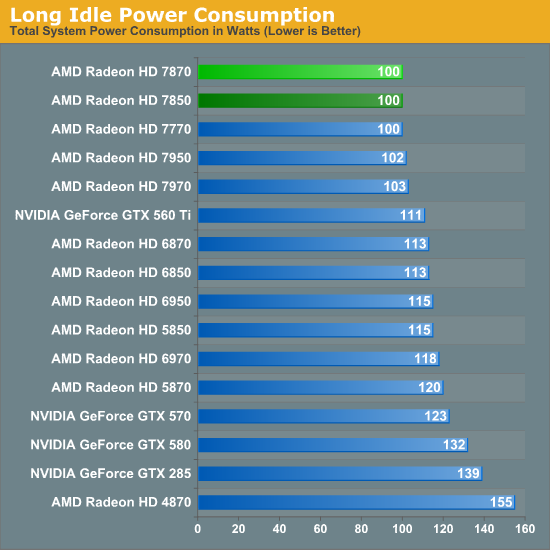
Long idle power consumption is virtually identical with the rest of the Southern Islands cards thanks to AMD’s ZeroCore Power technology. The next closest card is the GTX 560 Ti, and that’s at nearly 10W higher.
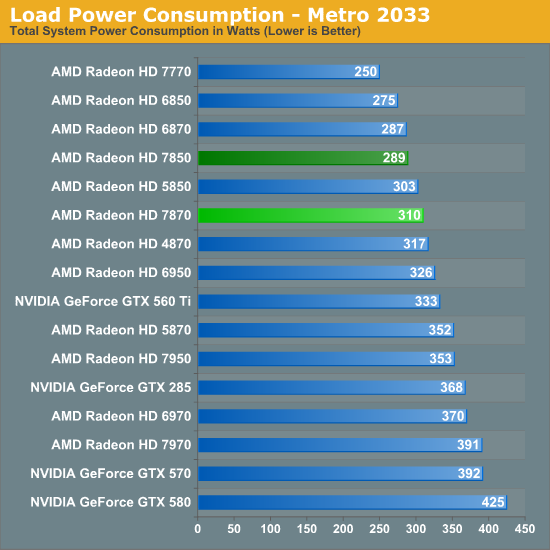
Moving on to load power testing, we have Metro 2033. Load power consumption here is about where you’d expect it to be, with the 7800 setups drawing more at the wall than the 6800 setups, but less than the 7900 and 6900 series. This is largely a consequence of performance, as the higher rendering performance of the 7800 series versus the 6800 series drives up CPU power consumption in order to generate more frames.
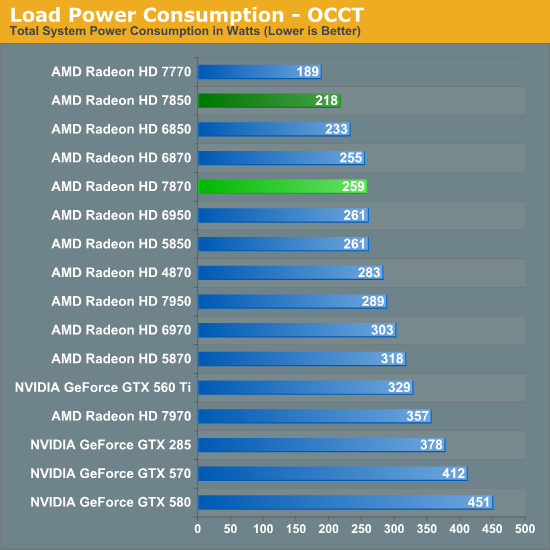
OCCT on the other hand gives us a more purified look at power consumption, and as you’d expect for 28nm it looks good. The 7870 ends up drawing only a few more watts at the wall compared to the 6870, showcasing the fact that the 7800 series is a drop-in replacement for the 6800 series from a power consumption perspective. The 7850 looks even better, capping out at 15W below the 6850, most likely as a result of PowerTune keeping the card firmly at 150W. Though it’s interesting to note that the measurements at the wall don’t perfectly align with the differences in PowerTune limits, with the 7850 drawing 30W more than the 7770 at the wall compared to a 50W PT difference, while the 7950 draws 30W more at the wall over the 7870 even though there’s only supposed to be a 10W PT difference.
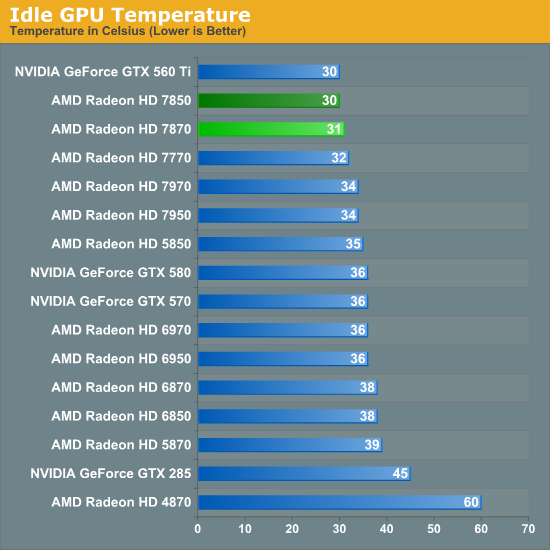
AMD’s latest generation blowers do quite well with idle temperatures and we can see it here. At 30C for the 7850 it’s every bit as cool as the GTX 560 Ti, while the entire 7800 series is around 5-8C cooler than the 6900.
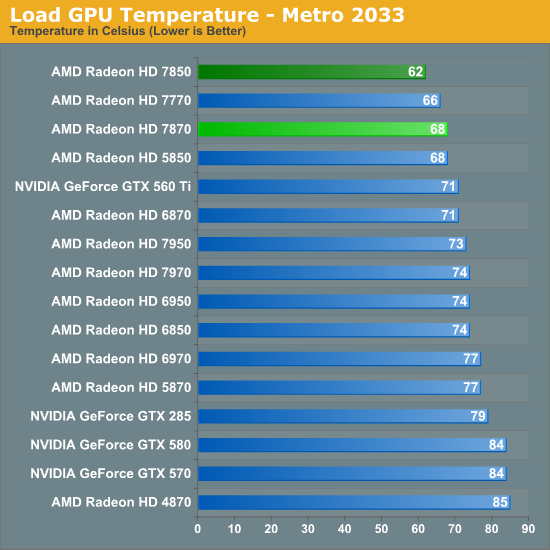
Under load, Metro temperatures are also quite good. At 62C the 7850 is the coolest card in this performance class, but keep in mind that it’s basically using an oversized cooler; retail cards will be open air coolers with much different characteristics. Otherwise at 68C the 7870 is still among the coolest cards, coming ahead of even the historically cool GTX 560 Ti, never mind the much hotter 6900 series.

Load temperatures climb under OCCT, but again the 7800 series is among the coolest temperatures we see. Here we see the 7870 peak at 73C, whereas its last generation counterpart would be at 80C and the GTX 570 at a toasty 87C.
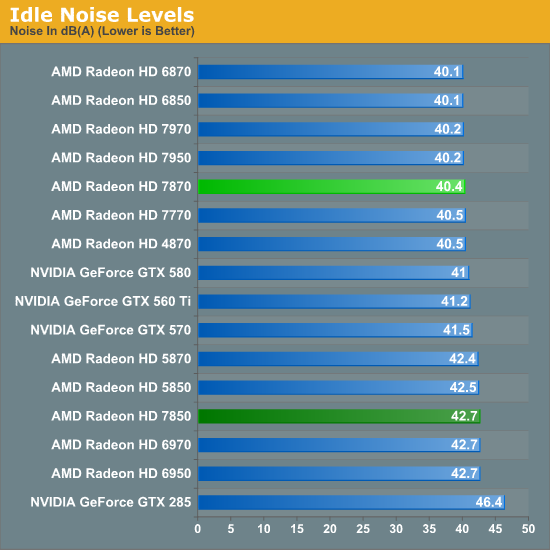
Moving on to noise testing, there are no major surprises at idle, with the 7870 hugging 40db. For whatever reason the 7850’s minimum fan state is roughly 200RPM higher than the 7870’s, but since no one will be using this cooler it’s not a significant result.
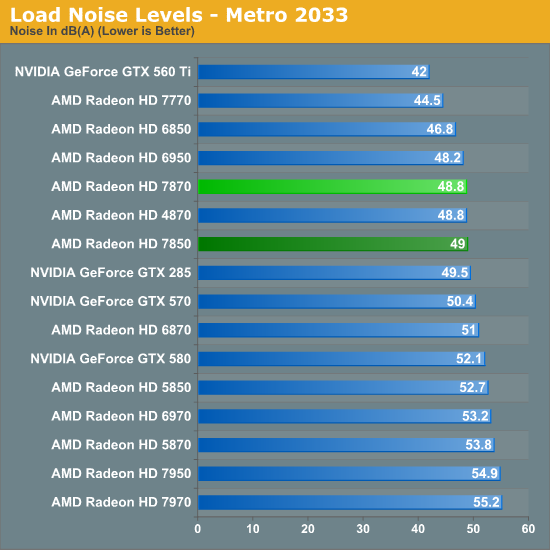
Consistent with AMD’s other 7000 series cards, we’re once again seeing the consequences of AMD’s aggressive cooling policies coupled with the use of a blower. At 48.8dB the 7870 is still quieter than the blower-based 6870, but it’s significantly louder than the open air cooled GTX 560 Ti, even though the latter consumes far more power and generates far more heat. This doesn’t make the use of a blower the wrong choice, but combined with aggressive cooling policies it does hurt AMD. The GTX 570, in spite of using much more power than the 7870, is only less than 2dB louder even though it too uses a blower.

Last, but not least we have our OCCT noise results. Unlike Metro the 7800 series does better on a relative basis here, but this is mostly because NVIDIA doesn’t have a power throttling system quite like PowerTune. At 51.9dB the 7870 is not the quietest card, but it still manages to beat the 6970 and the PowerTune-less 6870.
All things considered there are no great surprises here on a relative basis, as the 7800 series performs like we’d expect for a blower based sub-200W video card. Due to TSMC's 28nm process AMD greatly improves on their performance/power and performance/noise ratios with the 7800 series compared to the 6800 and 6900 series, while for their power class the 7800 series is slightly ahead of the pack on both power consumption and noise.
With that said, keep in mind that since most of AMD’s partners will be using open air coolers these results won’t be applicable to most retail cards. So for the temp/noise characteristics of retail cards you’ll want to look at individual card reviews when those start appearing later this month. This is particularly true for the 7950, where all of the retail cards will be using a different design than our sample.










173 Comments
View All Comments
rburnham - Monday, March 5, 2012 - link
I tend to skip one or two generations of video cards before upgrading, but the 7850 looks like a fairly respectable upgrade over my current 6850. I love that low power draw, although I might wait until someone like MSI comes out with a quieter version.CeriseCogburn - Thursday, March 8, 2012 - link
Your 6850 is 2 watts higher power draw at idle. But you're a gamer, so load draw is important. The 7850 is 14 watts higher power draw on normal load, and 26 watts more on high load. Powertune slider only increases that.smoka - Monday, March 5, 2012 - link
A lot of people are saying power draw is not important, but it is for some of us upgrading. I have been running a GTX460 for about a year now and I'm finally thinking about jumping on the Eyefinity bandwagon. I was eying the 6950 a few weeks ago, but I decided to wait for the 78xx to come out. My plan is to move to a single card and run at a lower resolution (3072x768 or 3840x1024) until I can upgrade to a CF setup and run at 5760x1080.Also keep in mind that I have a 600W PSU, which would need an upgrade a 69xx CF or GTX570/580 SLI setup. Many people who are in the mid-high end gaming market (which the 78xx is aimed at) don't have a 1000W PSU. Upgrading to these top-tier PSUs is also another expense to add to an already expensive graphics card overhaul.
The 7870 series fits the bill exactly for me, except for the $350 price-point. I really wanted the it to be priced at $300 or less. I am hoping it will hit this price either due to brand competition, store promotion, or after kepler release.
kallogan - Monday, March 5, 2012 - link
Actually i care about power consumption more than stupid power hungry raw performance.You are not responsible citizens when buying nvidia stuff. Buy amd and save the planet.
HAHA
compvter - Monday, March 5, 2012 - link
Sure performance/price matters most, but what i find interesting in current amd generation cards is zerocore that allows me to keep my computer running with low power draw when i don't use it. I don't really care about power draw when i am using computer, but i do care about noise, and those are kind of related. Still most of the cards are silent enough for me, but most of the time my coputer is on idle (or long idle) with software running that i can't turn off (irc client), so zerocore would save me a lot of money compared to Nv offerings. Still i am interested to see what nv offers, but at the moment im considering 7870 to replace my 3870x2. Would go 79xx, but don't want to buy new case =/mattgmann - Monday, March 5, 2012 - link
save the planet...lol. Though saving on the electricity bill would be nice. The power hungry 4890 tandem in my rig surely adds a few tens of dollars a month to my bill.pieguy - Monday, March 5, 2012 - link
In the paragraph about 7800 series voltage, you mention 7950 voltages but I think you mean 7850 voltage, else I am not understanding...Also, a question about these voltages of 1.213 - 1.219. I don't know much on the subject. If these are the voltages under load, what are they actually set to (before vdroop)? If this voltage is standard for these cards, does it mean that we shouldn't be concerned about using this voltage on other 28nm 7XXX series cards for extra OC headroom and 24/7 usage? I'm just trying to figure out a max "safe" 24/7 voltage for my 7950 since the overclocking scales really well with voltage increases.
Thanks for the great review!
Ryan Smith - Monday, March 5, 2012 - link
Hi Pie, thanks for the correction. As for the voltages, those are the VIDs, so it's without vdroop. As for what a safe voltage is, there's no easy answer to that. Though 1.21v is likely safe for 7900 cards that are already in the 1.17v range.ObeseMaurice - Monday, March 5, 2012 - link
I bought a 2GB 6950 2 weeks ago for $240 and $20 mail in rebate. The 7870 is worse on all resolutions of Battlefield 3 and priced significantly higher. Very unimpressive product launch from AMD.silverblue - Monday, March 5, 2012 - link
Has anybody stopped to think how much extra performance you might get from these cards when AMD has proper drivers for them, or is this considered a moot point? Needless to say, nowhere on the BF3 benchmarks in this review is the 7870 slower than the 6950, rather it's a consistent 20% faster. Throughout the review the 7870 ranges from about 15% (Batman 1920x1200) - 70% (Civ5 1920x1200) faster depending on the title. Granted, the gap isn't always this large at 2560x1600 but it's still sizeable in a good number of cases. Are you in fact referring to the 7850?AMD are pricing these cards at that level because they can. It's certainly not going to last forever.